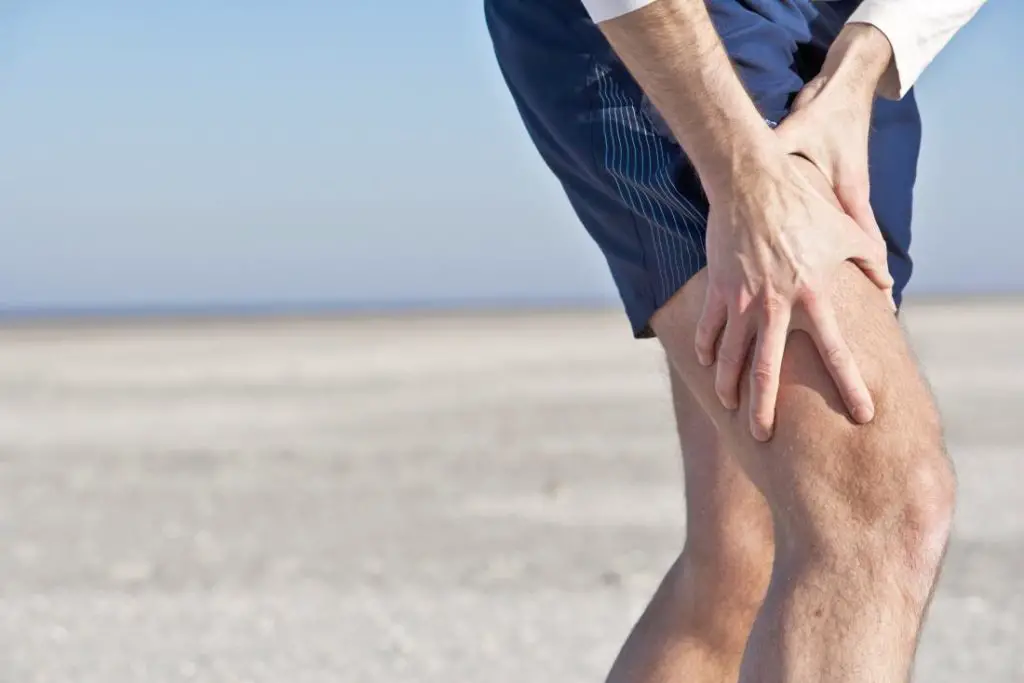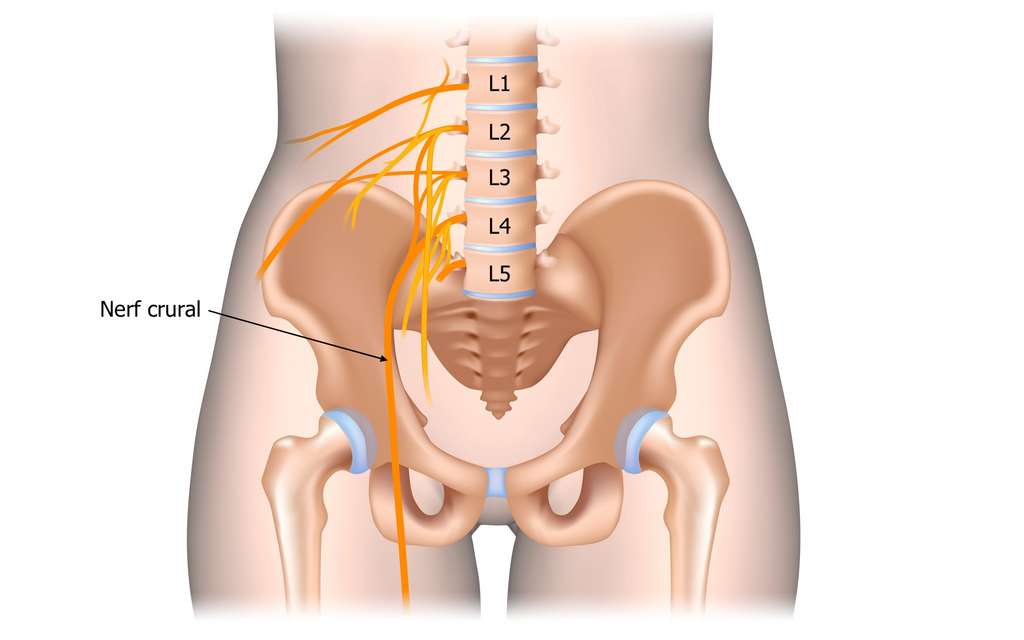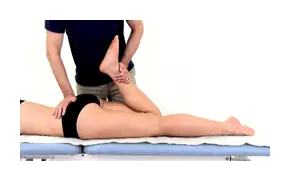Article reviewed and approved by Dr. Ibtissama Boukas, physician specializing in family medicine
You have pains that radiate forward in the leg, don't you? It is even possible that this pain is associated with sensations of tingling, numbness, or electric shocks.
Anyway, you've heard of the cruralgia, and look for exercises that can relieve your symptoms.
First thing to understand: There are no exercises found on the Internet that can be specifically adapted to your particular needs or personal condition. For this, it will be necessary to consult a health professional who will integrate therapeutic exercises within a global care.
Second thing to understand: Pain that radiates down the leg does not necessarily come from the crural nerve. To learn more about this condition (including the causes, the return to sport and the treatments available), I strongly urge you to consult the following article:
Cruralgia from A to Z: symptoms duration, treatment
Likewise, if your symptoms are more on the back of the thigh, I also invite you to inquire about the sciatica, a more common condition that also causes radiating pain in the leg.
Once these elements are understood, allow me to share with you 5 exercises that I suggest to my patients when they consult for pain radiating to the leg. Obviously, I will have made a diagnostic hypothesis beforehand, and adapted the treatment accordingly.
On the other hand, I allow myself to share these relatively safe exercises to offer you possible solutions. So be sure to take it gradually, to respect your symptoms at all times, and to consult in case of doubt!
Exercise 1: Lumbar extension
Note: These exercises are inspired by the McKenzie method. They will only be effective if your preferential direction is the extension (explained in detail in next article).
1. Lie on your stomach.
2. Raise the trunk by placing yourself on the elbows according to tolerance.
3. If the previous movement is comfortable and/or reduces your symptoms, bring the elbows forwards towards you to accentuate the lumbar extension.
4. If the previous movement is comfortable and/or reduces your symptoms, place yourself on your stomach and push with your hands in order to bring your trunk into extension.
5. Repeat the extension movement about ten times, taking breaks if necessary, and being progressive.
6. If these movements seem to help you, I invite you to consult a therapist familiar with the McKenzie method.
Exercise 2: Dynamic quadriceps stretch
Note: If pain causes numbness, tingling or electric shocks, reduce range of motion. I also encourage you to consult if this is the case.
1. Lie on your stomach, and secure a strap (or towel) around the ankle of the affected leg.
2. Pull the strap so as to bring your heel towards your buttocks, until you feel a start of stretching at the front of your thigh.
3. Hold for 3 seconds and return to the initial position
4. Repeat about XNUMX times, taking breaks as needed.
This exercise aims to mobilize the crural nerve in its sheath. Be careful, this is not a stretching of the crural nerve, because the tension is maintained for a short time only!
Exercise 3: “Flossing” of the crural nerve
Footnotes: If the pain causes numbness, tingling or electric shocks, reduce the range of motion. I also encourage you to consult if this is the case.
1. Stand up, making sure you have support to maintain your balance.
2. In one motion, bring the heel of the affected leg toward your buttock as you tilt your head forward. Hold the end position for 3 seconds.
3. As you lower your leg, bring your head back (or neutral) as well.
4. Repeat about XNUMX times, taking breaks as needed.
Like the previous exercise, the objective is to mobilize the crural nerve in its sheath, this time in a standing position.
Exercise 4: Unilateral sit-stand
Note: Make sure the environment around you is safe and secure to avoid the risk of falling.
1. Sit on a chair keeping your back straight.
2. Raise the healthy leg so that your affected leg is in contact with the floor.
3. Lean forward and rise so that only the affected leg is used.
4. If possible, sit down using only the affected leg. Otherwise, sit normally (on 2 legs).
In this case, the goal of the exercise is to strengthen the quadriceps muscle. Indeed, this muscle is innervated by the crural nerve, and is often atrophied in the presence of cruralgia. This exercise will therefore promote functional recovery of the affected muscle.
Exercise 5: Dynamic psoas stretch
1. Get into a knight's stance. The affected leg should be placed back.
2. Bring your pelvis forward while keeping your back straight until you feel tension on the top (or front) of your thigh.
3. Hold for 3 seconds and return to starting position.
4. Repeat about XNUMX times, taking breaks as needed.
The objective is to dynamically soften the psoas muscle (to avoid over-stretching the crural nerve and therefore potentially irritating it). This will reduce nerve pressure and relieve symptoms.
How to apply these exercises on a daily basis?
Ok, you have above a series of 5 exercises regularly prescribed by health professionals to relieve the symptoms of cruralgia. Now, how do we apply these exercises in practice on a daily basis?
Already, I recommend that you do NOT do all the exercises at the same time. Why ? Imagine that your symptoms increase after trying the prescribed movements. You couldn't tell which of these exercises was responsible for the increased pain. Conversely, it is difficult to identify which exercise or exercises are the most effective when you do them all at the same time.
The solution ? Here is what I recommend to my patients:
- Start with exercise 1, then reassess your symptoms in light of this new exercise.
- The next day, incorporate exercise 2 into your routine to determine the impact on your pain.
- The next day, include exercise 3 in your routine (you should then do exercises 1-2-3).
- After 5 days you should be able to do all the exercises suggested. This slow and safe progression will allow you to identify potentially harmful exercises in your case, while avoiding overloading your body.
Crural nerve: Anatomy, route, pain
Article reviewed and approved by Dr. Ibtissama Boukas, doctor specializing in family medicine It is…
Cruralgia and pregnancy: How to manage seizures? (Exercises)
Article reviewed and approved by Dr. Ibtissama Boukas, doctor specializing in family medicine The…
Léri's sign: Detect a herniated disc or cruralgia
Article reviewed and approved by Dr. Ibtissama Boukas, doctor specializing in family medicine Le…
6 Home Remedies for Cruralgia (Natural Treatment)
Do you suffer from thigh pain? Or, has your doctor diagnosed you with...
Cruralgia and tumour: what is the link?
There may be a link between cruralgia and tumor. In short, when a tumor develops…
How to unlock the crural nerve? (Is it possible ?)
Cruralgia occurs when the nerve in the front of the thigh is irritated…
Conclusion
Here are 5 exercises that can serve as a starting point if you ever experience symptoms of cruralgia. Although they do not replace a consultation, they can relieve you somewhat, and encourage you to move more in avoiding prolonged rest.
If you try any exercise for your back, and don't see any improvement after a while, that's a sign you need to seek professional help.
Often it's because the exercises aren't suited to your condition, or done the wrong way. And if you ever suffer from one of following symptoms, see a healthcare professional right away.
My name is Anas Boukas and I am a physiotherapist. My mission ? Helping people who are suffering before their pain worsens and becomes chronic. I am also of the opinion that an educated patient greatly increases their chances of recovery. This is why I created Healthforall Group, a network of medical sites, in association with several health professionals.
My journey:
Bachelor's and Master's degrees at the University of Montreal , Physiotherapist for CBI Health,
Physiotherapist for The International Physiotherapy Center







